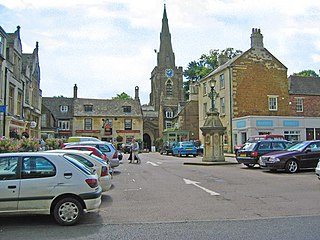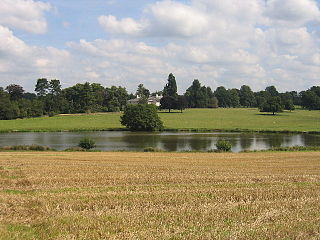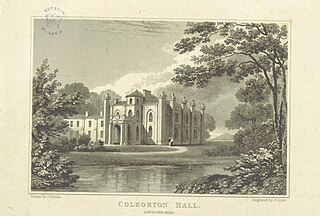
Stockerston Hall is a late-18th-century English country house in Leicestershire, near the town of Uppingham, Rutland. It is a Grade II listed building. [1]

An English country house is a large house or mansion in the English countryside. Such houses were often owned by individuals who also owned a town house. This allowed them to spend time in the country and in the city—hence, for these people, the term distinguished between town and country. However, the term also encompasses houses that were, and often still are, the full-time residence for the landed gentry that ruled rural Britain until the Reform Act 1832. Frequently, the formal business of the counties was transacted in these country houses.

Leicestershire is a landlocked county in the English Midlands. The county borders Nottinghamshire to the north, Lincolnshire to the north-east, Rutland to the east, Northamptonshire to the south-east, Warwickshire to the south-west, Staffordshire to the west, and Derbyshire to the north-west. The border with most of Warwickshire is Watling Street.

Uppingham is a market town in the county of Rutland in the East Midlands of England, located on the A47 between Leicester and Peterborough, about 6 miles (10 km) south of the county town, Oakham on the A6003 road.
The Manor of Stockerston was owned by the Boyville family in the 15th century and passed by marriage to Sothill and then to Drury. It was sold by Henry Drury in 1580 to John Burton of Braunston, whose son was the first of the Burton baronets of Stockerston. In 1633, Sir Thomas Burton Bt was High Sheriff of Leicestershire [2] and in 1682 Sir Thomas Burton Bt had the same honour. [3]

Stockerston is a village and civil parish in the Harborough district of Leicestershire, England, located on the border with Rutland, by the Eye Brook. According to the 2001 census the parish had a population of 35. The population remained less than 100 at the 2011 census and is included in the civil parish of Horninghold.
There have been two baronetcies created for persons with the surname Burton, one in the Baronetage of England and one in the Baronetage of Ireland. Both creations are extinct.
This is a list of Sheriffs and High Sheriffs of Leicestershire, United Kingdom. The Sheriff is the oldest secular office under the Crown. Formerly the High Sheriff was the principal law enforcement officer in the county but over the centuries most of the responsibilities associated with the post have been transferred elsewhere or are now defunct, so that its functions are now largely ceremonial. Under the provisions of the Local Government Act 1972, on 1 April 1974 the office previously known as Sheriff was retitled High Sheriff. The High Sheriff changes every March.
The Burtons were impoverished by the English Civil War and sold the estate to Sir Charles Dunscombe in about 1685. The Dunscombes demolished the old manor house in about 1797 and built the present Georgian style mansion upon its foundations in about 1800. The attractive red brick and stone dressed entrance front of five bays has a central Tuscan order porch.

The English Civil War (1642–1651) was a series of armed conflicts and political machinations between Parliamentarians ("Roundheads") and Royalists ("Cavaliers") over, principally, the manner of England's governance. The first (1642–1646) and second (1648–1649) wars pitted the supporters of King Charles I against the supporters of the Long Parliament, while the third (1649–1651) saw fighting between supporters of King Charles II and supporters of the Rump Parliament. The war ended with the Parliamentarian victory at the Battle of Worcester on 3 September 1651.

The Tuscan order is in effect a simplified Doric order, with un-fluted columns and a simpler entablature with no triglyphs or guttae. While relatively simple columns with round capitals had been part of the vernacular architecture of Italy and much of Europe since at least Etruscan architecture, the Romans did not consider this style to be a distinct architectural order. Instead the Tuscan order, presented as a standardized formal order, is an invention of Italian Renaissance writers largely motivated by nationalism.
The house was sold by Dunscombe in about 1807 and a number of owners and tenants followed including Walker, Bellairs, Fenwicke, Stevenson and from 1930 Whitgreave. By 1954 it was the residence of John A. F. March Phillipps de Lisle, High Sheriff of Leicestershire [4] who was succeeded by his son Everard, also high sheriff in 1974. [5] The house and 269-acre (1.09 km2) estate were sold following the latter's death in 2003.
John Adrian Frederick March Phillipps de Lisle was an English businessman and a cricketer who played first-class cricket for Leicestershire and was captain of the team in the 1930 season. He also served as High Sheriff of Leicestershire. He was born in Kensington, London and died at his home, Stockerston Hall, near Uppingham, Rutland.









